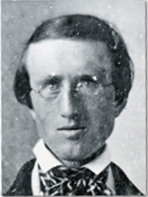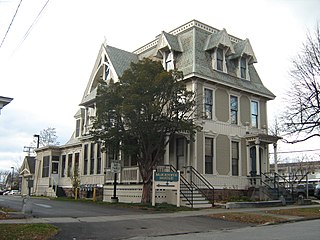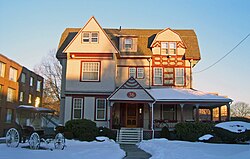
Isabella Beecher Hooker was a leader, lecturer and social activist in the American suffragist movement.

Olivia Langdon Clemens was the wife of the American author Samuel Langhorne Clemens, better known as Mark Twain.

The Harriet Beecher Stowe House is a historic house museum and National Historic Landmark at 73 Forest Street in Hartford, Connecticut that was once the home of Harriet Beecher Stowe, author of the 1852 novel Uncle Tom's Cabin. Stowe lived in this house for the last 23 years of her life. It was her family's second home in Hartford. The 5,000 sq ft cottage-style house is located adjacent to the Mark Twain House and is open to the public. It was listed on the National Register of Historic Places in 1970, and declared a National Historic Landmark in 2013.

The Park River is a tributary of the Connecticut River in Hartford, Connecticut. It was officially named the Park River in 1892 after Bushnell Park, through which it flowed in downtown Hartford. A local newspaper had advocated for that name rather than the “’Hog River’” name which was then in use.Between 1940 and the 1980s, the 2.3-mile (3.7 km) river was buried by the Army Corps of Engineers to prevent the spring floods regularly caused by increased surface runoff from urban development.

The Gilbert Millspaugh House is located on Church Street in Walden, New York, United States. It is a 2005 addition to the National Register of Historic Places, built in a Victorian style for a local man named Richard Masten. Later it was home to Gilbert Millspaugh, son of a local furniture retailer.

129 High Street in Reading, Massachusetts is a well-preserved, modestly scaled Queen Anne Victorian house. Built sometime in the 1890s, it typifies local Victorian architecture of the period, in a neighborhood that was once built out with many similar homes. It was listed on the National Register of Historic Places in 1984.

The Loring Residence and Clinic was the first facility built to provide medical services to Valparaiso, Indiana. The residence has continued to provide for public service through its current use by the Valparaiso Woman's Club. Dr. Loring used his home as his medical office until his death in 1914. It was Loring's initial efforts that brought medical care to the county and provided for the first hospital. Although private, it became the county's first public hospital when Loring sold the building in 1906 to build his home and clinic.

The Harriet Phillips Bungalow is located on NY 23B on the western edge of Claverack, New York, United States. It is a stucco-sided frame building dating from the 1920s.

The Katharine Seymour Day House is a historic house at 77 Forest Street in the historic Nook Farm district of Hartford, Connecticut. Built in 1884 for a local businessman seeking to compete stylistically with the adjacent Mark Twain House, it is a good local example of Queen Anne architecture. It now serves as the administrative center and library for the Harriet Beecher Stowe Center. It was listed on the National Register of Historic Places in 1971.

The Charles E. Beach House is a historic house at 18 Brightwood Lane in West Hartford, Connecticut. Built in 1900–01, it is one of the town's finest examples of Shingle style architecture. It was listed on the National Register of Historic Places on August 23, 1990.

The John Calvin Stevens House is an historic house at 52 Bowdoin Street in the West End neighborhood of Portland, Maine. Built in 1884, it was the home of architect John Calvin Stevens, and was one of Portland's earliest examples of Shingle style architecture. The house was prominently used by Stevens in promotion of the style, and was listed on the National Register of Historic Places in 1973.

The North Grove Street Historic District is located along the north end of that street in Tarrytown, New York, United States. It consists of five mid-19th century residences, on both sides of the street, and a carriage barn. In 1979 it was listed on the National Register of Historic Places.

The Delavan Terrace Historic District is located along the street of that name in Northwest Yonkers, New York, United States. It consists of 10 buildings, all houses. In 1983 it was recognized as a historic district and listed on the National Register of Historic Places.

The Dixon–Markle House is located at the corner of East Cooper Avenue and South Aspen Street in Aspen, Colorado, United States. It is a wood frame house erected in the 1880s. In 1987 it was listed on the National Register of Historic Places along with other properties in the city.

The Smith–Elisha House, sometimes known just as the Elisha House or the Christmas Tree House, is located on West Main Street in Aspen, Colorado, United States. It is a wood frame structure in the Queen Anne style built in the late 19th century. In 1989 it was listed on the National Register of Historic Places.

John Hooker (1816-1901) was an American lawyer, judge, and abolitionist as well as a reformer for women's rights. He married Isabella Beecher Hooker in 1841 and lived in Farmington and Hartford, Connecticut. With his brother-in-law, Francis Gillette, he purchased 140 acres in 1853, and they established the Hartford neighborhood known as "Nook Farm." Nook Farm was a community of reformers, politicians, writers and friends; Harriet Beecher Stowe, Mark Twain, Isabella Beecher Hooker, Francis Gillette, and Charles Dudley Warner were the most famous residents.

The Martin L. Kelsey House is a historic house at 43 Elmwood Avenue in Burlington, Vermont. Built in 1879 for a local merchant, it is a distinctive and architecturally varied house, with elements of the Second Empire, Queen Anne, and Stick styles on display. It was listed on the National Register of Historic Places in 1983, and now forms part of a senior housing complex.

Nook Farm is a historical neighborhood in the Asylum Hill section on the western edge of Hartford, Connecticut, USA.

The John and Isabella Hooker House is a historic house at 140 Hawthorn Street in Hartford, Connecticut. Built in the 1850s and twice enlarged, it is a distinctive and large example of Italianate country villa architecture. It was listed on the National Register of Historic Places in 1979.

The North Ann Arbor Street Historic District is a residential historic district, consisting of the houses at 301, 303, and 305-327 North Ann Arbor Street in Saline, Michigan. It was listed on the National Register of Historic Places in 1985.
























